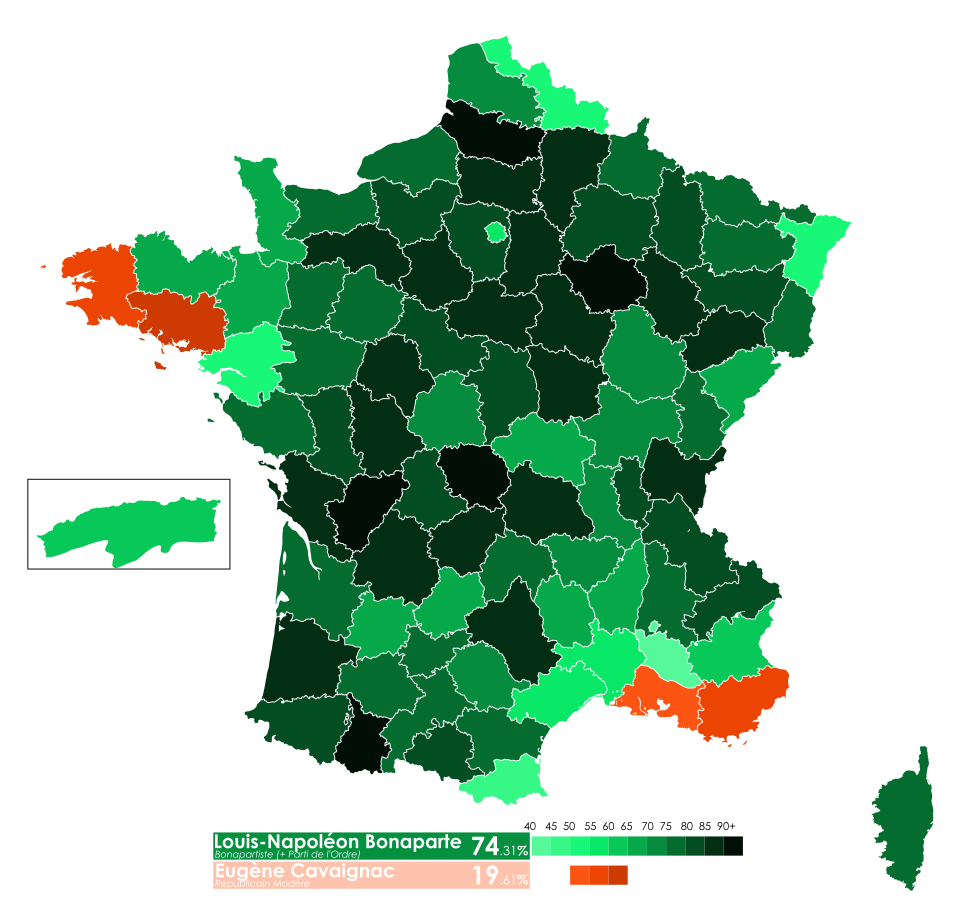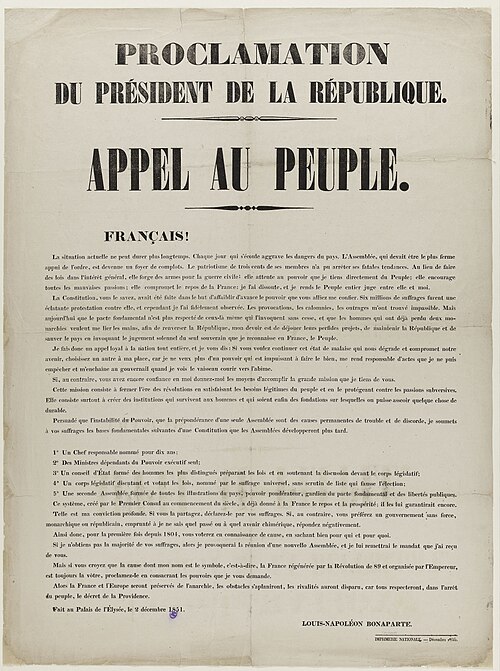OCR Specification focus:
‘Election of Louis Napoleon; personality; aims and policies as president; Coup of 1851; domestic policy as emperor.’
Introduction
The election of Louis Napoleon Bonaparte in 1848 marked a decisive turning point in French history, combining his dynastic legacy, political ambition, and authoritarian transformation of France.
The 1848 Presidential Election
The presidential election of December 1848 was the first to be decided by universal male suffrage in France, making it one of the most significant democratic experiments in nineteenth-century Europe. Louis Napoleon, nephew of Napoleon I, stood as a candidate and triumphed overwhelmingly. His victory owed much to his name, which evoked both the glory of the Napoleonic Empire and the promise of national stability after the upheavals of the 1848 Revolution.
Factors Behind His Victory
Several key factors explain his landslide win:
Napoleonic Legacy: The Bonaparte name symbolised order, stability, and national pride, which contrasted sharply with the political instability of the Second Republic.
Peasant Support: The rural electorate, forming the majority of voters, viewed him as a protector of property and religion.
Middle-Class Backing: Landowners and bourgeois elements trusted him to defend conservative values and oppose radical socialism.
Image of Independence: He was seen as a candidate above party politics, neither monarchist nor republican, offering unity in a fractured political environment.
Election Results
Louis Napoleon secured around 5.5 million votes, vastly outpacing General Cavaignac, his closest rival. This result revealed the enduring emotional power of Napoleonic symbolism and the electorate’s rejection of both radicalism and conservative monarchist divisions.

Results of the 1848 French presidential election by department. The map shows Louis-Napoleon Bonaparte’s overwhelming support across most of France, with departmental winners clearly indicated. It visually reinforces the scale and geography of his victory. Source
Personality of Louis Napoleon
Louis Napoleon’s personality was crucial in shaping his presidency and later imperial rule. His combination of determination, mystique, and caution defined his political style.
Traits and Perceptions
Reserved but Calculating: Often described as enigmatic, he concealed his plans while quietly building networks of influence.
Persistent Ambition: Despite earlier failed coup attempts in 1836 and 1840, he never abandoned his dynastic ambitions.
Visionary Ideals: He claimed to represent a modern, socially-minded Bonapartism, blending authoritarian control with promises of progress.
Popular Image: His carefully constructed persona, reinforced by propaganda and symbols of his uncle’s legacy, projected him as a saviour of France.
Bonapartism: A political ideology centred on authoritarian leadership, popular legitimacy through plebiscites, nationalism, and social reform, associated with Napoleon I and Napoleon III.
This blend of mystique and populism allowed Louis Napoleon to appeal simultaneously to conservatives, moderates, and the working poor.
Aims and Policies as President
Louis Napoleon’s presidency (1848–1852) was marked by attempts to consolidate his authority while addressing the nation’s social and economic divisions.
Political Aims
To transcend party rivalries and embody national unity.
To defend order against radical socialism and revolutionary threats.
To reassert France’s influence on the European stage.
Domestic Policies
Economic Initiatives: He promoted public works projects and credit facilities to address unemployment.
Social Policies: He showed sympathy for workers, promising better conditions while avoiding radical redistribution.
Church Relations: He cultivated the Catholic Church’s support, strengthening ties with conservative rural France.
Control of Opposition: Through newspapers and policing, he limited radical republican influence.
Limitations
Despite his popular mandate, the Constitution of 1848 restricted him to a four-year term without immediate re-election. This constitutional limit soon clashed with his personal ambitions.
The Coup of 1851
The clash between constitutional constraints and personal ambition culminated in the Coup d’État of 2 December 1851, staged on the anniversary of Napoleon I’s coronation and the Battle of Austerlitz.

Official “Appel au peuple” proclamation of 2 December 1851. This poster announces Louis-Napoleon’s coup that ended the Second Republic and prefigured the establishment of the Second Empire. Source
Causes of the Coup
Re-election Crisis: The Assembly refused to amend the constitution to allow his re-election.
Political Deadlock: Tensions between the president and the legislature paralysed policymaking.
Ambition: Louis Napoleon sought to maintain power and complete his vision of a Bonapartist France.
Execution of the Coup
The Assembly was dissolved and opponents arrested.
Paris was placed under military control.
A plebiscite in December 1851 legitimised the coup, with around 7.5 million votes in favour.
Outcomes
The coup marked the end of the Second Republic. By late 1852, Louis Napoleon declared himself Emperor Napoleon III, inaugurating the Second Empire.
Domestic Policy as Emperor
As emperor, Napoleon III pursued a blend of authoritarianism and modernisation, reshaping French society and politics.
Authoritarian Rule
Centralised Power: He controlled the press, restricted political opposition, and relied on plebiscites for legitimacy.
Imperial Image: Symbols, ceremonies, and architecture reinforced his role as heir to Napoleon I.
Social and Economic Modernisation
Industrial Growth: Support for railways, banking reforms, and free trade agreements encouraged rapid industrialisation.
Urban Renewal: The rebuilding of Paris under Baron Haussmann modernised infrastructure and improved public health.
Social Welfare: He promoted credit schemes and housing initiatives, attempting to integrate the working classes into his empire.
Balancing Act
Napoleon III’s policies sought to preserve order while offering progress. He combined repression of political dissent with tangible improvements in living standards, consolidating support across diverse groups.
This combination of electoral triumph, enigmatic personality, calculated coup, and transformative domestic agenda defined Louis Napoleon’s path from president of the Second Republic to Emperor of the French.
FAQ
His failed coups in 1836 (Strasbourg) and 1840 (Boulogne) initially undermined his credibility, leading to imprisonment. However, they kept his name in the public eye and reinforced his persistence.
By 1848, his reputation for determination and loyalty to the Napoleonic legacy made him seem a serious contender, especially to those nostalgic for the stability of the Empire.
Louis Napoleon employed pamphlets, articles, and images to associate himself with his uncle’s achievements.
Portraits and lithographs emphasised his resemblance to Napoleon I.
Pamphlets such as Extinction du paupérisme positioned him as sympathetic to the poor while avoiding radical socialism.
This propaganda helped bridge class divisions, appealing to both peasants and bourgeois voters.
The Church saw him as a bulwark against socialism and secular republicanism.
His respect for religion reassured conservative rural voters.
He promised to uphold Catholic influence in education and society.
This alignment gave him credibility among the devout peasantry, a decisive electoral bloc in 1848.
Most European powers opposed radical revolution and accepted Louis Napoleon’s consolidation of power.
Britain and Austria viewed the coup pragmatically, preferring stability over republican unrest.
Only a minority of liberal voices abroad criticised the authoritarian turn.
This muted international response gave Napoleon freedom to secure his position without external challenge.
Plebiscites allowed him to claim direct support from the people, bypassing hostile assemblies.
December 1851: around 7.5 million voted in favour of the coup.
November 1852: another plebiscite endorsed his transformation into Emperor Napoleon III.
By linking his authority to popular votes, he justified authoritarian rule as the “will of the nation.”
Practice Questions
Question 1 (2 marks):
In which year did Louis Napoleon stage his coup d’état, and what was its immediate constitutional effect?
Mark scheme:
1 mark for identifying the year 1851.
1 mark for stating the immediate constitutional effect: dissolution of the Assembly / end of the Second Republic / establishment of his personal authority.
Question 2 (6 marks):
Explain two reasons why Louis Napoleon won the 1848 presidential election so decisively.
Mark scheme:
Award up to 3 marks per explanation. Each explanation must include both identification and development.
Napoleonic Legacy (up to 3 marks)
1 mark for identifying the importance of the Bonaparte name.
1 additional mark for explaining that it evoked national glory, stability, or order.
1 additional mark for linking it to widespread voter appeal across classes.
Peasant and Rural Support (up to 3 marks)
1 mark for identifying strong peasant backing.
1 additional mark for explaining their desire for protection of property and religion.
1 additional mark for linking rural majority to decisive vote share.
Alternative valid explanations (up to 3 marks each, maximum 2 developed points credited):
Middle-class support and fear of socialism.
His image as a candidate above party divisions.
Maximum of 6 marks overall.

